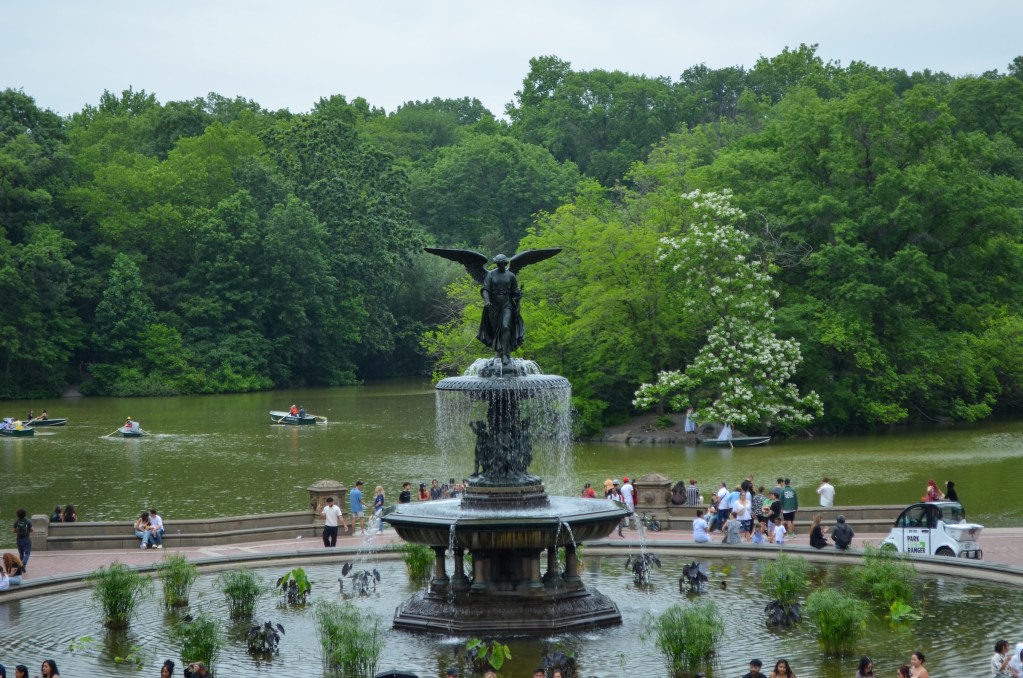The Queer History of Central Park’s Bethesda Fountain


This article is part of Hyperallergic’s 2025 Pride Month series, spotlighting moments from New York’s LGBTQ+ art history throughout June.
Off to one side of the Bethesda Terrace, one of the most photographed sites in Manhattan’s Central Park, visitors gathered for an impromptu salsa dancing session on Sunday, June 15, against the backdrop of “Angel of the Waters,” the sculpture that forms the centerpiece of the landmark fountain. Tourists crowded nearby, capturing photos of the artwork against the lush surrounding greenery.
The Neoclassical bronze, dedicated in 1873, is the enduring work of Emma Stebbins, the first woman to be commissioned to create a public artwork in New York City. The sculptor was also in a committed partnership with the popular actor Charlotte Cushman, and it is speculated that she modeled the piece after her beloved.
Appearing as if she might step forward off her plinth with one hand softly extended outward, the sculpture bears large angel wings and robes that appear to crease in the wind. From afar, it looks as if she might be flying.

At the sculpture’s dedication, 10 years after its commissioning in 1863, Stebbins explained that the work referenced the biblical angel who infuses the waters of Bethesda with healing properties in the Gospel of John, according to historian Jessica MacLean of the Central Park Conservancy. The nonprofit oversees the Manhattan green space.
Stebbins dedicated the work to the Croton Aqueduct, New York City’s first water supply system, which opened in 1842 and helped prevent the spread waterborne diseases including cholera and typhoid, MacLean said. One of Stebbins’s own brothers had died of cholera just years before. Born in 1815, Stebbins was the daughter of a wealthy banker and found support for her artistic ambitions among her well-to-do family. She was also the sister of Henry Stebbins, the president of the New York Stock Exchange and Central Park commissioner, leading to allegations that her selection for the commission was nepotistic.

The average New York Times reader in the late 19th century might have understood Cushman to be Stebbins’s “friend” rather than her romantic partner. At the time of the couple’s nearly two-decade relationship, terms to describe a romantic or sexual relationship between two women, such as “gay,” “lesbian,” or “queer,” were not yet common parlance. Stebbins and Cushman’s relationship might have been described as a “Boston marriage,” a domestic partnership between two women that was generally accepted in the Victorian era based on the assumption that women were bereft of sexual desire.

In letters, MacLean told Hyperallergic, Cushman referred to Stebbins as her wife. Cushman wrote that she wore the “badge” of her marriage to Stebbins on her left ring finger. The two fell in love in Rome, where Stebbins moved in her 40s to live in an expatriate community of artists and study sculpture, MacLean said. It was there that Stebbins created Angel of Waters.
Stebbins was shy, according to MacLean, and relied on Cushman to promote her work. The couple returned to the United States in 1870 after Cushman was diagnosed with breast cancer, after which Stebbins stopped working.
“Like many women of their time, they found greater personal freedom abroad, but even after leaving Rome, they continued to defy societal norms by openly living as a couple in America,” MacLean said.
Upon the unveiling of “Angel of the Waters,” critics abhorred the work. A Times article from 1873 described a “positive thrill of disappointment” that befell the public as the “cloaking” was removed from the sculpture.
“All had expected something great, something of angelic power,” the author wrote, describing the sculpture as a “feebly-pretty idealess thing.”

Some 150 years later, MacLean describes the work as not only beautiful but also revelatory of a story of “healing and hope.” The statue and its history are featured on an ongoing Queer Central Park Tour facilitated by the Central Park Conservancy.
“Their relationship adds a meaningful dimension to the history of public art in New York City,” MacLean said, “one shaped by women and queer artists whose contributions have often gone unrecognized.”





